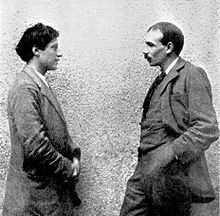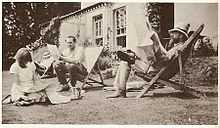List of Bloomsbury Group people
List of people associated with the Bloomsbury Group. Much about Bloomsbury appears to be controversial, including its membership: indeed, some would maintain that "the three words 'the Bloomsbury group' have been so much used as to have become almost unusable".[1]
Group of friends and relatives that became a movement
The Bloomsbury group started as a loose collective of friends and relatives living near Bloomsbury, London. Some of them knew each other from their time as student in Cambridge. Around the first World War most of its key members had left the Bloomsbury area, where some of them later returned.
The members of the Bloomsbury Group denied being a group in any formal sense, they however shared common values, among which a strong belief in the arts.[2]
Core Members
The group had ten core members:[3]
- Clive Bell, art critic
- Vanessa Bell, Post-impressionist painter
- E. M. Forster, fiction writer
- Roger Fry, art critic and Post-impressionist painter
- Duncan Grant, Post-impressionist painter, who later became a member of the Camden Town Group
- John Maynard Keynes, economist
- Desmond MacCarthy, literary journalist
- Lytton Strachey, biographer
- Leonard Woolf, essayist and non-fiction writer
- Virginia Woolf, fiction writer and essayist
Included according to Leonard Woolf
In the 1960s, Leonard Woolf additionally listed the following Bloomsbury Group members:[4]
- 'Old Bloomsbury':
- Adrian Stephen
- Karin Stephen
- Saxon Sydney-Turner
- Mary (Molly) MacCarthy
- Later additions:
Mentioned in various sources as included in the Bloomsbury Group
Various sources include the following:
- Lady Ottoline Morrell[4]
- Dora Carrington[4]
- James Strachey[4]
- Alix Strachey[4]
- Lydia Lopokova, Keynes' wife, accepted in the group[5]
Generally not seen as members of the Bloomsbury Group
Died before the group really existed
- Thoby Stephen, brother to key members Adrian Stephen, Virginia Woolf and Vanessa Bell
Ottoline Morrell circle
The Bloomsbury Group only partially identified with Lady Ottoline Morrell, but attended her parties at Garsington Manor. Others present:
- Eardley Knollys
- Philip Morrell
- Aldous Huxley and his wife Maria Nys
Hogarth Press
Hogarth Press was the publishing house owned by Leonard and Virginia Woolf after they had left the Bloomsbury area in 1917. Staff members and authors published by that company were not necessarily part of the Bloomsbury Group. The following are generally not seen as part of the Bloomsbury Group:
- Published by Hogarth Press:
- T. S. Eliot[4]
- Katherine Mansfield[4]
- Vita Sackville-West, "Hogarth Press's best-selling author".[6]
- Julia Strachey, Lytton Stratchey's niece
- Hogarth Press personnel:
- John Lehmann, later starting his own publishing company
LGBT extended groups

The Bloomsbury Group plays a prominent role in the LGBT history of its day. While still in the Bloomsbury area LGBT activity was all very much in a single group (e.g. Duncan Grant, a homosexual with bisexual leanings,[7] having affairs with Maynard Keynes, James Strachey, Adrian Stephen, David Garnett and straight Vanessa Bell). Names of LGBT people outside the Bloomsbury Group strictly speaking include:
Later the groups differentiated. Keynes married Lopokova, and no longer belonged to any of the LGBT groups. Other groups more or less splitted according to the location where they started to live:
- Lady Ottoline Morrell provided housing for Aldous Huxley at Garsington where he was married to Maria Nys after the war.
- Also Duncan Grant and David Garnett had to work on the land as conscientious objectors during World War I. They started living with Vanessa Bell (also her son Julian) in Charleston Farmhouse:
- Francis Birrell started a bookshop together with David Garnett later on.

- Also during the First World War Lytton Strachey and Dora Carrington moved to Tidmarsh Mill House. Later (in a menage a trois with straight Ralph Partridge) they moved to Ham Spray House.
- Roger Senhouse, had been Strachey's last lover
- E. M. Forster spent his time as conscientious objector in Egypt, and remained there some time after the First World War. When returning to England his circle of LGBT friends and acquaintances included:
- After Virginia Woolf had moved to Monk's House,
- she would meet Vita Sackville-West, writing her Roman à clef Orlando: A Biography about her. Woolf also met the LGBT people around her, including:[8]
- Harold Nicolson, Sackville-West's husband
- Benedict Nicolson, their son
- Violet Trefusis, her former lover
- Harold Nicolson, Sackville-West's husband
- Ethel Smyth was another later acquaintance of Virginia Woolf [9]
- Katherine Mansfield and John Lehmann were LGBT acquaintances linked to the publishing company she owned with her husband (Hogarth Press)
- she would meet Vita Sackville-West, writing her Roman à clef Orlando: A Biography about her. Woolf also met the LGBT people around her, including:[8]
Others
Others not generally considered part of the Bloomsbury Group properly speaking (some of them only befriended individual group members, not or only partially sharing their views or not in the same creative mindset):
- Bernard Meninsky
- Mulk Raj Anand
- Garman sisters Lorna and Kathleen
- Jacques and Gwen Raverat (continued letter exchanges with Virginia Woolf after moving to France)
- Bertrand Russell
- Arthur Waley
- Hugh Walpole[4]
- G. E. Moore
- Ann Bridge
- Frances Partridge, married Ralph Partridge after Lytton Stratchey's and Dora Carrington's death and continued living in Ham Spray house.
Later offspring
Too young to be part of the original Bloomsbury group:
- Nigel Nicolson, son of Harold Nicolson and Vita Sackville-West, also biographer of Virginia Woolf
- Cressida Bell, daughter of Quentin Bell
- Burgo Partridge son of the widower of Dora Carrington, who later married a daughter of Angelica and David Garnett
Critics of Bloomsbury
- Wyndham Lewis
- Roy Campbell (poet)
- D. H. Lawrence criticised the homosexual tendencies, though close to the core members of the group[10]
References
- ↑ Lee, p. 262
- ↑ Ousby, p. 95
- ↑ Avery, p. 33.
- ↑ 4.0 4.1 4.2 4.3 4.4 4.5 4.6 4.7 Lee, p. 263
- ↑ Clarke, p. 56
- ↑ Lee, p. 447
- ↑ Angelica Garnett, Deceived with Kindness (1984) p. 33 (in 1995 edition)
- ↑ Souhami, pp. 123-124
- ↑ Spalding 1991
- ↑ Francis Spalding, Duncan Grant: A Biography. (1997) p. 169-170: (around 1915 Lawrence warned David Garnett against homosexual tendencies like those of Francis Birrell, Duncan Grant and Keynes:) "Lawrence's views, as Quentin Bell was the first to suggest and S. P. Rosenbaum has argued conclusively, were stirred by a dread of his own homosexual susceptibilities, which are revealed in his writings, notably the cancelled prologue to Women in Love"
Bibliography
- Todd Avery. Radio Modernism: Literature, Ethics, and the BBC, 1922-1938. Ashgate Publishing, Ltd.; 1 January 2006. ISBN 978-0-7546-5517-6.
- Peter Clarke. Keynes. Bloomsbury Press, 2009. pp. 56, 57. ISBN 978-1-60819-023-2.
- Angelica Garnett. Deceived with Kindness (1984)
- Hermione Lee, Virginia Woolf London: Chatto & Windus, 1996.
- Ian Ousby ed., The Cambridge Guide to Literature in English (Cambridge 1995)
- Souhami, Diana (1997). Mrs. Keppel and Her Daughter. Portrait of a Lesbian Affair: St. Martin's Griffin. pp. 123–223. ISBN 978-0-312-19517-5.
- Frances Spalding. Virginia Woolf: Paper Darts: the Illustrated Letters (1991)